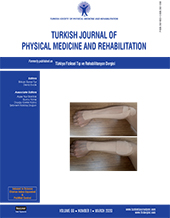Low levels of serum vitamin D3 are associated with fibromyalgia syndrome in pre-menopausal women: A pilot study
Patients and methods: Between October 2012 and April 2013, a total of 80 premenopausal patients (mean age 38.1±7.1 years; range, 18 to 50 years) with non-specific musculoskeletal symptoms were included in the study. The determination of 25-hydroxyvitamin D3 (25(OH)D3) deficiency was based on a reference value of 25 ng/mL. Patients with deficient serum 25(OH)D3 levels (<25 ng/mL, n=40) comprised the patient group, while those with adequate serum 25(OH)D3 levels (≥25 ng/mL, n=40) comprised the control group. Data including demographic characteristics, laboratory parameters (i.e., calcium, phosphorus, alkaline phosphatase [ALP], and parathyroid hormone [PTH]), and clinical findings (i.e., proximal muscle weakness [PMW] and periarticular sensitivity [PAS]) were recorded and compared between the groups. Pain severity was evaluated using the visual analog scale (VAS), psychological status was evaluated using the Beck Depression Inventory (BDI), and quality of life (QoL) was evaluated using the Short Form 36 (SF-36). The diagnosis of FMS was made based on the 2010 criteria of the American College of Rheumatology.
Results: Although there were no statistically significant differences in the demographic characteristics between the groups, ALP and PTH levels were higher in the patient group (p<0.05). The VAS, frequency of FMS, PMW, and PAS were also significantly higher in the patient group (p<0.05). Depression and the mental and physical component scores of the SF-36 did not significantly differ between the two groups (p<0.05).
Conclusion: Our study results suggest that patients with low 25(OH)D3 levels may more frequently experience FMS and pain than healthy individuals.
Keywords : Depression, fibromyalgia syndrome, pain, quality of life, vitamin D

















